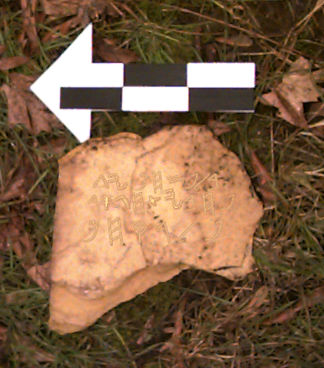Did God's Wife Live In Cherokee?
However, Dr. Michaela Randleman, Associate Professor of History at Morris College in Irish Grove isn't so sure.

The Fraspers Stone
(photo courtesy Morris College)
"Of course, that doesn't account for the Fraspers Inscription."
Dr. Randleman refers to another piece of local limestone, uncovered in the backyard of Cherokee resident Jed Fraspers: a flat rock about 7" x 4"that bears faint remains of the incised marks of an inscription. Fraspers found the stone while landscaping his property six months after the discovery at the Get 'N' Gone site. Any connection with the unearthed platform, which lies roughly a hundred yards from the Fraspers home, is uncertain. Most experts have assumed it to be a Native American script, such as the still-undecipered script once used by the Cherokee Indians. That would be a surprising find in itself, since---despite the town's name---the Cherokee tribe is not known to have ever ranged into the area presently known as Iowa. Nor has any other such inscription has been found in the state. Even more surprising, though, is the interpretation now being put forward by Dr. Randleman.
Dr. Randleman says the inscription may be Hebrew.
"Of course," explains Dr. Randleman, "this is not the familiar squarish script of Modern Hebrew. That script was brought back to Judah in the 5th Century BCE by returnees from the Babylonian Exile, and displaced an older script now known to epigraphers as Paleo-Hebrew. I believe the Fraspers Inscription could be written in Paleo-Hebrew."
Dr. Randleman argues that the fragmentary inscription, which is faint and would contain only the latter (i.e., leftward) portions of its four lines, can be read:
...of grain from Elishama
...[to] my lady Asherah
...[da]mned forever the s[eed]
...[Ki]ng Hezek[iah]
"The inscription appears to commemorate a dedicatory offering of grain by one Elishama to Asherah!" Dr. Randleman explained, growing a little excited. "The Hebrew personal name 'Elishama'---or 'God Hears'---is familiar from a number of persons in the Old Testament. Far more exciting, however, is 'my lady Asherah!'"
Dr. Randleman continued with rising enthusiasm, "Asherah is a name previously found in several ancient Near Eastern inscriptions and ostraca which refer to 'YHWH and his Asherah,' and many scholars believe her to have been His consort before a monotheistic theology came to dominate Israelite religion between the rise of the Prophetic movement in the 8th Century and the Babylonian Exile in the 6th. She may also be the 'Queen of Heaven' referred to in other Bible passages. The word 'asherah' can refer either to the goddess or to the upright wooden poles that were the primary cultic objects dedicated to her worship---although in either usage the word is mistranslated as 'grove' in all major English Bibles. Asherah worship was attacked by the monotheist prophets Isaiah, Micah, and Jeremiah, and cultic practices associated with her were among the chief targets of monotheist campaigns by King Hezekiah and King Josiah. The very fact that Josiah had to remove one of her cultic poles from beside the altar of YHWH in the Jerusalem Temple demonstrates succinctly that even at that late date she was officially worshipped in the Temple itself!"
"Naturally," continued Dr. Randleman, "this makes the apparent inclusion of a curse on King Hezekiah and his descendants all the more intriguing. It's possible that a body of Israelites who believed in both YHWH and Asherah---convinced like the Israelites who rebuke Jeremiah at Chapter 44 of that book that monotheistic 'reform' was blasphemy which had provoked divine punishment---may have separated themselves from the larger community during his reign to worship in a 'pure' manner. Such Israelites would, of course, revile Hezekiah for corrupting the worship of YHWH and the Goddess. The platform at this hilltop site here is consistent with Israelite 'high places' of worship used before the monopoly eventually achieved by the Jerusalem Temple, such as the one excavated at Beth-El, which were primary targets of monotheist polemics. It even appears to have indentations in which to set the upright asherah-poles, like Beth-El."
"I'll admit that doesn't explain how these sectarian Israelites found themselves in Northwest Iowa perhaps a thousand years after Hezekiah, but some have suggested that other North American inscriptions thought to be in the Cherokee script, such as the Bat Creek Inscription, are of Semitic origin. Who knows?"
